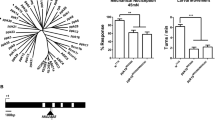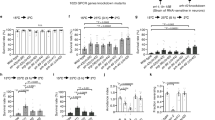Abstract
Touch sensitivity in animals relies on nerve endings in the skin that convert mechanical force into electrical signals. In the nematode Caenorhabditis elegans, gentle touch to the body wall is sensed by six mechanosensory neurons1 that express two amiloride-sensitive Na+ channel proteins (DEG/ENaC). These proteins, MEC-4 and MEC-10, are required for touch sensation and can mutate to cause neuronal degeneration2,3. Here we show that these mutant or ‘d’ forms of MEC-4 and MEC-10 produce a constitutively active, amiloride-sensitive ionic current when co-expressed in Xenopus oocytes, but not on their own. MEC-2, a stomatin-related protein needed for touch sensitivity4, increased the activity of mutant channels about 40-fold and allowed currents to be detected with wild-type MEC-4 and MEC-10. Whereas neither the central, stomatin-like domain of MEC-2 nor human stomatin retained the activity of full-length MEC-2, both produced amiloride-sensitive currents with MEC-4d. Our findings indicate that MEC-2 regulates MEC-4/MEC-10 ion channels and raise the possibility that similar ion channels may be formed by stomatin-like proteins and DEG/ENaC proteins that are co-expressed in both vertebrates and invertebrates5,6,7,8. Some of these channels may mediate mechanosensory responses.
This is a preview of subscription content, access via your institution
Access options
Subscribe to this journal
Receive 51 print issues and online access
$199.00 per year
only $3.90 per issue
Buy this article
- Purchase on Springer Link
- Instant access to full article PDF
Prices may be subject to local taxes which are calculated during checkout




Similar content being viewed by others
References
Chalfie, M. & Sulston, J. Developmental genetics of the mechanosensory neurons of Caenorhabditis elegans. Dev. Biol. 82, 358–370 (1981).
Driscoll, M. & Chalfie, M. The mec-4 gene is a member of a family of Caenorhabditis elegans genes that can mutate to induce neuronal degeneration. Nature 349, 588–593 (1991).
Huang, M. & Chalfie, M. Gene interactions affecting mechanosensory transduction in Caenorhabditis elegans. Nature 367, 467–470 (1994).
Huang, M., Gu, G., Ferguson, E. L. & Chalfie, M. A stomatin-like protein necessary for mechanosensation in C. elegans. Nature 378, 292–295 (1995).
Fricke, B. et al. Epithelial Na+ channels and stomatin are expressed in rat trigeminal mechanosensory neurons. Cell Tissue Res. 299, 327–334 (2000).
Mannsfeldt, A. G., Carroll, P., Stucky, C. L. & Lewin, G. R. Stomatin, a MEC-2 like protein, is expressed by mammalian sensory neurons. Mol. Cell Neurosci. 13, 391–404 (1999).
Tavernarakis, N., Shreffler, W., Wang, S. & Driscol, M. unc-8, a DEG/ENaC family member, encodes a subunit of a candidate mechanically gated channel that modulates C. elegans locomotion. Neuron 18, 107–119 (1997).
Sedensky, M. M., Siefker, J. M. & Morgan, P. G. Model organisms: new insights into ion channel and transporter function. Stomatin homologues interact in Caenorhabditis elegans. Am. J. Physiol. Cell Physiol. 280, C1340–C1348 (2001).
Chalfie, M. & Au, M. Genetic control of differentiation of the Caenorhabditis elegans touch receptor neurons. Science 243, 1027–1033 (1989).
García-Añoveros, J., Garcia, J. A., Liu, J. D. & Corey, D. P. The nematode degenerin UNC-105 forms ion channels that are activated by degeneration- or hypercontraction-causing mutations. Neurons 20, 1231–1241 (1998).
Adams, C. M. et al. Ripped pocket and pickpocket, novel Drosophila DEG/ENaC subunits expressed in early development and in mechanosensory neurons. J. Cell Biol. 140, 143–152 (1998).
Waldmann, R., Champigny, G., Voilley, N., Lauritzen, I. & Lazdunski, M. The mammalian degenerin MDEG, an amiloride-sensitive cation channel activated by mutations causing neurodegeneration in Caenorhabditis elegans. J. Biol. Chem. 271, 10433–10436 (1996).
Canessa, C. M. et al. Amiloride-sensitive epithelial Na+ channel is made of three homologous subunits. Nature 367, 463–467 (1994).
Rajaram, S., Spangler, T. L., Sedensky, M. M. & Morgan, P. G. A stomatin and a degenerin interact to control anesthetic sensitivity in Caenorhabditis elegans. Genetics 153, 1673–1682 (1999).
Palmer, L. G. Interactions of amiloride and other blocking cations with the apical Na channel in the toad urinary bladder. J. Membr. Biol. 87, 191–199 (1985).
McNicholas, C. M. & Canessa, C. M. Diversity of channels generated by different combinations of epithelial sodium channel subunits. J. Gen. Physiol. 109, 681–692 (1997).
Gu, G., Caldwell, G. A. & Chalfie, M. Genetic interactions affecting touch sensitivity in Caenorhabditis elegans. Proc. Natl Acad. Sci. USA 93, 6577–6582 (1996).
Muller, A. H., Gawantka, V., Ding, X. & Hausen, P. Maturation induced internalization of beta 1-integrin by Xenopus oocytes and formation of the maternal integrin pool. Mech. Dev. 42, 77–88 (1993).
Lande, W. M., Thiemann, P. V. & Mentzer, W. C. Jr Missing band 7 membrane protein in two patients with high Na, low K erythrocytes. J. Clin. Invest. 70, 1273–1280 (1982).
Huang, M. Mechanosensory genes in Caenorhabditis elegans. PhD thesis, Columbia Univ. (1995).
Snyers, L., Umlauf, E. & Prohaska, R. Oligomeric nature of the integral membrane protein stomatin. J. Biol. Chem. 273, 17221–17226 (1998).
Snyers, L., Umlaug, E. & Prohaska, R. Cysteine 29 is the major palmitoylation site on stomatin. FEBS Lett. 449, 101–104 (1999).
Salzer, U. & Prohaska, R. Stomatin, flotillin-1, and flotillin-2 are major integral proteins of erythrocyte lipid rafts. Blood 97, 1141–1143 (2001).
García-Añoveros, J., Samad, T. A., Woolf, C. J. & Corey, D. P. Transport and localization of the DEG/ENaC ion channel BNaCl α to peripheral mechanosensory terminals of dorsal root ganglia neurons. J. Neurosci. 21, 2678–2686 (2001).
Price, M. P. et al. The mammalian sodium channel BNC1 is required for normal touch sensation. Nature 407, 1007–1011 (2000).
Lai, C. C., Hong, K., Kinnell, M., Chalfie, M. & Driscoll, M. Sequence and transmembrane topology of MEC-4, an ion channel subunit required for mechanotransduction in Caenorhabditis elegans. J. Cell Biol. 133, 1071–1081 (1996).
Kleckner, N., Bender, J. & Gottesman, S. Uses of transposons with emphasis on Tn10. Methods Enzymol. 204, 139–180 (1991).
Hille, B. Ion Channels of Excitable Membranes. (Sinauer, Sunderland, Massachussetts, 2001).
Chillaron, J. et al. An intracellular trafficking defect in type I cystinuria rBAT mutants M467T and M467K. J. Biol. Chem. 272, 9543–9549 (1997).
Woodhull, A. M. Ionic blockage of sodium channels in nerve. J. Gen. Physiol. 61, 687–708 (1973).
Acknowledgements
We thank S. Zhang for polyclonal anti-MEC-2(145–481); M. Driscoll for wild-type degenerin cDNAs; G. Stewart for hStomatin cDNA; S. Hollman for pSGEM (a derivative of pGEM-HE); the Developmental Studies Hybridoma Bank for monoclonal antibodies against Xenopus β-integrin; J. Art, S. Firestein and J. Yang for the loan of equipment. We also thank L. Chen for technical assistance and T. Lu and J. Yang for assistance with preliminary experiments. This work was supported by a research grant from the National Institute of General Medical Sciences, NIH (M.C.), a Human Frontiers Science Program postdoctoral fellowship (D.S.C.), and an NRSA postdoctoral fellowship from the National Institute of Deafness and Other Communication Disorders, NIH (M.B.G.)
Author information
Authors and Affiliations
Corresponding author
Ethics declarations
Competing interests
The authors declare no competing financial interests.
Rights and permissions
About this article
Cite this article
Goodman, M., Ernstrom, G., Chelur, D. et al. MEC-2 regulates C. elegans DEG/ENaC channels needed for mechanosensation. Nature 415, 1039–1042 (2002). https://doi.org/10.1038/4151039a
Received:
Accepted:
Issue Date:
DOI: https://doi.org/10.1038/4151039a
This article is cited by
-
SPFH protein cage — one ring to rule them all
Cell Research (2022)
-
Harnessing the power of genetics: fast forward genetics in Caenorhabditis elegans
Molecular Genetics and Genomics (2021)
-
GABAergic motor neurons bias locomotor decision-making in C. elegans
Nature Communications (2020)
-
Acid-sensing ion channels: dual function proteins for chemo-sensing and mechano-sensing
Journal of Biomedical Science (2018)
-
Identification of small-molecule ion channel modulators in C. elegans channelopathy models
Nature Communications (2018)
Comments
By submitting a comment you agree to abide by our Terms and Community Guidelines. If you find something abusive or that does not comply with our terms or guidelines please flag it as inappropriate.



